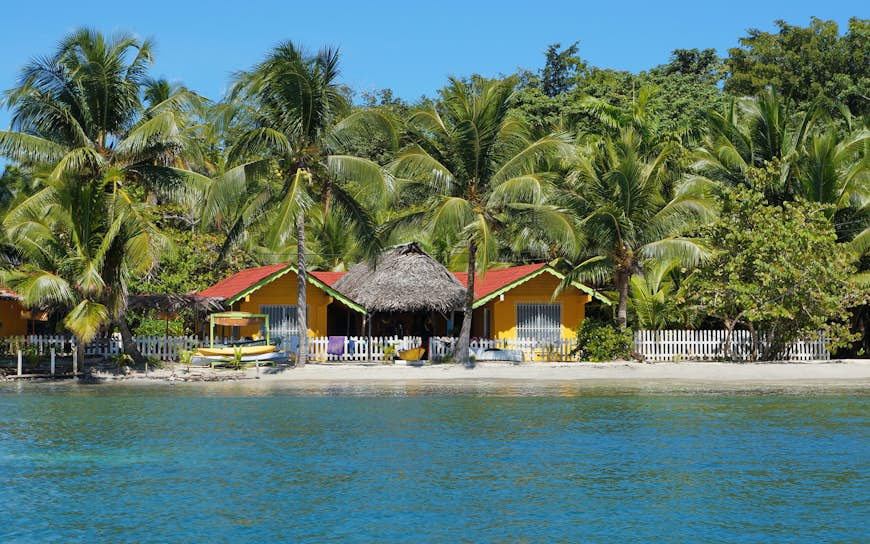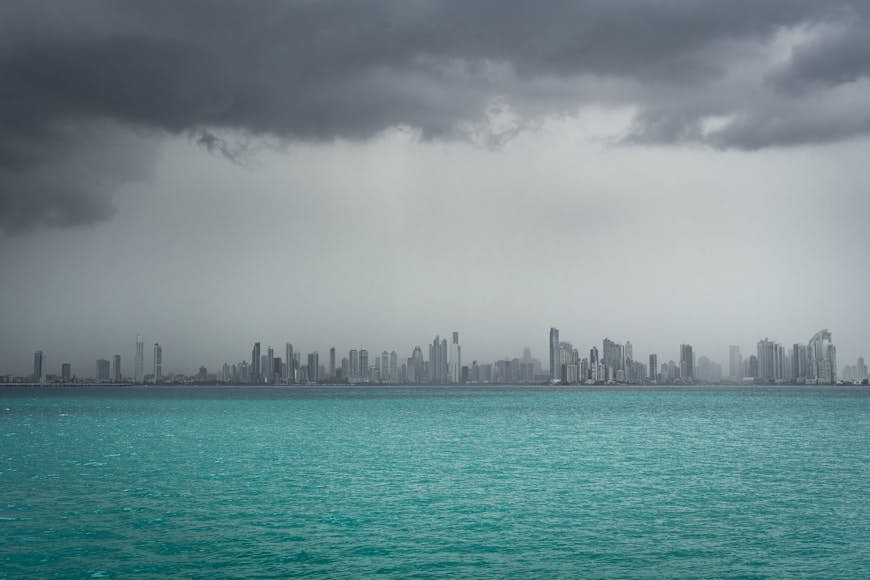Panama isn’t always expensive to visit. Traveling here is somewhat cheaper than traveling in Europe, Canada or the United States but somewhat pricier than Guatemala, Honduras or El Salvador.
It’s not the most expensive country in Central America – that prize goes to Costa Rica, closely followed by Belize – but thrifty travelers will need to plan carefully and sacrifice a few home comforts to keep costs to a minimum.
Fortunately, there are plenty of ways to save on food, lodgings, transport and excursions. The beaches are free and there’s no shortage of outdoor activities at Panama’s extensive and affordable national park system.
Here are our top tips for making your Panama adventure bueno, bonito y barato (good, nice and cheap).
Visit during the wet season
The wet season runs from May to November in Panama. Hotel rates can drop 10–30% during this period, but you will have to contend with bursts of torrential rain. Most downpours are quite brief, erupting in the afternoon and clearing an hour or two later, but several days of continuous downpours are not unknown. Certain activities, such as birdwatching and white water rafting, are much better in the rainy season.
Bocas del Toro has a highly changeable microclimate; the province is frequently wet when the rest of the country is dry, and sometimes vice versa. International flights to Panama are usually cheapest towards the end of the wet season, September to November.
If you only intend to visit western Panama, consider flying into Costa Rica
Many of Panama’s best attractions lay in the western provinces of Chiriquí and Bocas del Toro. If you don’t intend to travel beyond these areas, it’s sometimes (but not always) more economical to fly to San José in Costa Rica and then travel overland to Panama.
The direct bus from San José to the international border at Paso Canoas is an hour or so longer than the bus from Panama City to David (the second-largest city in Panama). You’ll have to submit to immigration formalities, which can be time-consuming.
The journey to Chiriquí is quicker and cheaper if you use intercity buses rather than international ones like Ticabus, which typically means longer commutes, higher prices and doesn’t stop at David.
Take the bus to and from Tocumen airport
An official taxi from Tocumen International Airport to downtown Panama City can set you back USD $30–40. A shared taxi is cheaper at around $15 per person if traveling solo.
The cheapest is the Metrobus, which costs no more than $1.25. Before leaving the airport, be sure to buy a rechargeable Metrocard, suitable for use on all Metrobuses and trains. They cost $5 and are good to go with $3 of fares included.
Note you will need a Metrocard to access long-distance services at Albrook bus station.

If you’re single, stay in a hostel dorm
Single travelers will find the cheapest digs in hostel dorms. Depending on location, you’ll get a few amenities and clean quarters for $10–20 per night.
Hostels are widespread in the major tourist hubs of Panama City, Boquete and Bocas del Toro, but less common elsewhere.
Couples and groups should stay in hotels
A private room in a cheap hotel is roughly the same price as a private room in a hostel, around $30–50 per night. In terms of comfort, however, hotel rooms are usually superior. The cheaper, more spartan rooms have fans and cold-water-only showers (air-conditioning can bump up prices by $15–20).
Some hotels have a handful of extremely basic, ultra-cheap quarters ($15–20) with a shared bathroom; ask reception if they have algo más económico (something cheaper) or un quarto con baño compartido (a room with shared bathroom).
Of course, the main disadvantage of using hotels is that you won’t have a shared kitchen at your disposal.
If you really want to save, sleep in a hammock
If you don’t mind roughing it, a hammock is the cheapest option. Hostels typically charge $2–5 per night for a pitch, and you may find locals prepared to offer the same service.
Use mosquito repellent, nets and/or insecticide coils, especially in the wet season. A warm blanket or sleeping bag may be necessary as temperatures can drop markedly at night, even in the steamy lowlands. Note it’s unsafe to sleep overnight in public spaces, including the beach.
Use public transportation in Panama City
Panama City cab drivers are notoriously wily. Overcharging is the norm, especially if you appear to be foreign. Worse yet, the city is frequently gridlocked, making travel by car slow and inefficient.
To save money and hassle, use Metrobuses and trains to get around ($0.25–0.35 per journey). If you must use taxis, try to agree on a price before getting in. And if your driver turns out to be a good one (many of them are), grab their cell phone number for future use.
Avoid tourist taxis and taxis that wait outside hotels. They will certainly overcharge you. Ubers are usually cheaper and easier than taxis.
Opt for buses over domestic flights
Domestic flights are undeniably fast. You can cross the entire country from Panama City to David by plane in about an hour. But with most round-trip fares exceeding $120, domestic flights are not cheap and carry a hefty carbon footprint too.
Although significantly slower (the same trip from Panama City to David takes seven to nine hours), the Terminales David-Panamá (TDP) or the Padafront buses are far more economical and environmentally friendly.

Gorge on fruit for breakfast
Fresh fruit in Panama is nutritious, delicious, ubiquitous and cheap. Options include a rainbow array of locally grown produce like pineapples, papayas, avocados, bananas, watermelons and oranges.
Get fruit from street vendors and local markets (a fruit breakfast in a restaurant is relatively poor value). Smoothies are another healthy and economic option.
Feast on carbs for lunch
If you intend to eat out a lot, lunch is the most economical meal of the day. Street food is thin on the ground in Panama, but cheap sit-down eateries abound and usually offer inexpensive set menus and/or carb-rich lunch buffets for around $5 a head.
A typical Panamanian lunch consists of a fatty meat or chicken main with a generous side of rice and beans plus a few slivers of (sometimes sweetened) plantain and a sugary drink. Sadly, vegans and vegetarians are not well-served in Panama.
You can generally drink the tap water
With the exceptions of Bocas del Toro, Guna Yala and other remote areas, the tap water in Panama is generally safe for consumption. Save on dollars and plastic waste by refilling your reusable water bottle at a kitchen faucet.

Choose guides and excursions carefully
Unless times are very tight, you will want to splurge on one or more tours. If you speak Spanish reasonably well, sourcing your own local guides can work out cheaper than using a tour operator.
It’s best to seek solid recommendations from your hotel or hostel they typically know where the best deals are. Most towns have an office of the national Environment Ministry, Mi Ambiente, and will point you in the right direction.
A guide to daily costs in Panama (US dollars)
Dorm bed in a hostel: $10–20
Basic hotel room for two: $30–50
Self-catering apartment (including Airbnb): $70–100+
Public transportation in Panama City: $0.25–0.35, or $1.25 for toll roads
Coffee: $1–3
Lunch for two: $10–20
Dinner for two: $20–40
Beer at the bar: $1–3
